Colic is a general term that refers to abdominal pain in the horse. Signs of pain may range from mild (looking at the flank, lifting the upper lip, no interest in eating, kicking the hind legs up towards the abdomen) to severe (repeatedly lying down and getting up, violently rolling up onto their backs or throwing themselves down on the ground).
Horses exhibiting signs of colic should be examined by a veterinarian immediately. Most horses with colic can be treated medically, but some may require surgical intervention. Delay in treatment can decrease the prognosis for survival.
Clinical signs depend on the cause of the colic and personality of the horse.
- Depression
- Inappetence (not interested in eating)
- Pawing
- Looking at the flank
- Lying down more than usual or at a different time from normal (Figure 1)
- Lying down, getting up, circling, laying down again repeatedly
- Curling/lifting the upper lip
- Kicking up at the abdomen with hind legs
- Rolling up onto back
- Stretching out (Figure 2)
- Dog-sitting (Figure 3)
- Groaning
- Sweating
- Increased heart rate (normal is 28–44 beats per minute)
- Visible abdominal distention (appearance of being bloated)
- Less than normal to no manure production
- Diarrhea
- Foals may roll up on their backs or grind their teeth and salivate excessively




Your veterinarian will ask you several questions and perform a physical exam.
- Questions may include: Recent travel, changes in feed or routine, medications, other episodes of colic, deworming/vaccination schedule
- Physical examination may include: Heart rate, respiratory rate, rectal temperature, listening for presence or absence of gastrointestinal sounds, color of mucous membranes (gums; Figure 4 shows gums that are too dark—this horse should be evaluated by a veterinarian immediately), skin turgor, digital pulses of the hooves, abdominal distention.

After that, your veterinarian may choose to do some or all of the following based on the initial physical examination:
- Passing a nasogastric tube to check for reflux (accumulation of fluid in the stomach)
- Rectal examination
- Blood work
- Abdominocentesis: Obtaining a sample of the fluid that surrounds the intestines from the abdomen (Figure 5)
- Ultrasound examination of the abdomen
- Gastroscopy to evaluate the stomach for ulcers
- Radiographs to look for sand or enteroliths (indicated in select cases)
Medical treatment generally consists of:
- Analgesia given intravenously (Banamine or sedation)
- Laxatives administered directly into the stomach via nasogastric tube (mineral oil or magnesium sulfate/Epsom salts)
- Re-hydration with oral or IV fluids
The majority of horses with colic will respond to medical treatment. If the horse remains uncomfortable, prompt re-examination by your veterinarian and possible referral to a surgical facility should be considered.
Surgical treatment should be considered if the horse remains uncomfortable demonstrating the above-mentioned signs of colic despite medical treatment or if there are specific indicators that were found by your veterinarian during medical workup that would indicate a surgical problem.
Surgical exploration by an ACVS board-certified large animal surgeon is performed at a surgical facility after placing the horse under general anesthesia with an incision made on the ventral midline. Many causes of surgical colic can be corrected; however, there are certain causes of colic that despite the most aggressive surgical approach and treatment, survival is guarded. Your surgeon may be able to determine that at the time of surgery.
Surgical success rates have improved dramatically over the years due to early referral and prompt surgical intervention.
Horses treated medically will typically be withheld from hay/grain until signs of colic have diminished. Once the colic signs resolve feeding will resume gradually based off of your veterinarians’ recommendations. Depending on the suspected cause of colic, preventative measures such as having the horse’s teeth floated, instituting a farm specific/appropriate deworming strategy or changing the type of feed or method of feeding may be recommended.
Horses treated surgically will typically require hospitalization for 5–7 days after surgery for continued monitoring for postoperative complications, administration of antibiotics, analgesics, intravenous fluids and to slowly start the horse back on feed ensuring no additional signs of colic. Specific post-operative recommendations will vary dependent on the surgical diagnosis, postoperative healing process, behavior of your horse, stabling/turnout facilities, etc. Generally, horses will need at least 3 months off from riding with an initial period of strict stall rest before resuming gradual increase in turnout followed by gradual increase in exercise/training or being ridden under saddle.
Prognosis varies greatly depending on the cause of the colic and how systemically compromised the horse was at the time of surgery, and if there were any postoperative complications. However, horses that are treated medically or those treated surgically that did not require removal of any portion of the intestine have a good prognosis.













